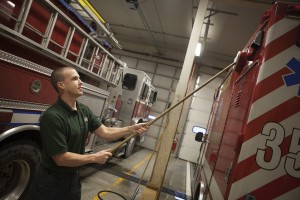Trial by fire
by joey |
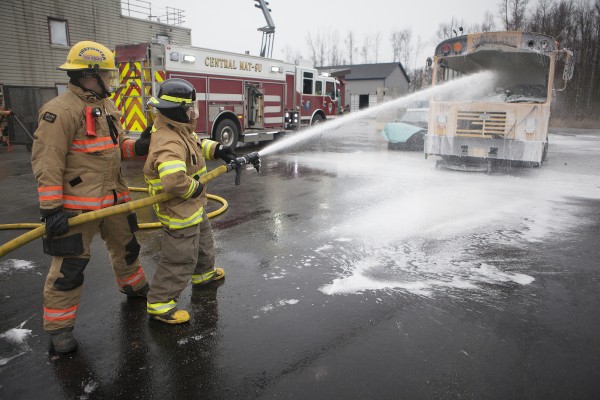
UAA fire and emergency services student Timothy Robbins hoses down a burned-out school bus during a training exercise at Central Mat-Su Fire Department in Wasilla. (Photo by Philip Hall / University of Alaska Anchorage)
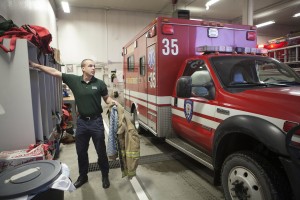
Forrest reacts to an early-morning emergency call at the fire house. (Photo by Philip Hall / University of Alaska Anchorage)
In Wasilla, Tim Robbins is bashing his way through a set of locked steel doors. Down the road in Chugiak, Forrest McDonald is racing to a nearby factory behind the wheel of a screaming ambulance. Other students are starting the long drive to Nikiski, where they'll spend two nights bunking at the local firehouse. In Anchorage, the calls haven't stopped pouring in for emergencies around the city.
It's just another Friday in Fire 295, a practicum course for fire and emergency services students at UAA. There's no classroom component for the three-credit elective; rather, students learn in firehouses across the state. The class requires 150 hours of on-the-job training during the semester, but that's only a minimum.
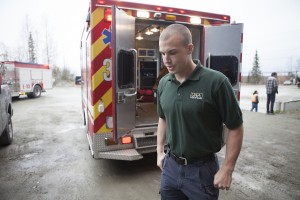
Forrest, whose mother also served as a volunteer firefighter, is working toward his EMT certifications as an emergency services major at UAA. (Photo by Philip Hall / University of Alaska Anchorage)
"Obviously, the goal is to do as much as you possibly can," said emergency services student Forrest McDonald, who regularly pulls 24-hour shifts at the Chugiak Volunteer Fire Department. Though students can continue as a volunteer after the class ends (and they occasionally do), the practicum offers one semester to make the most of UAA's strong connections throughout the region.
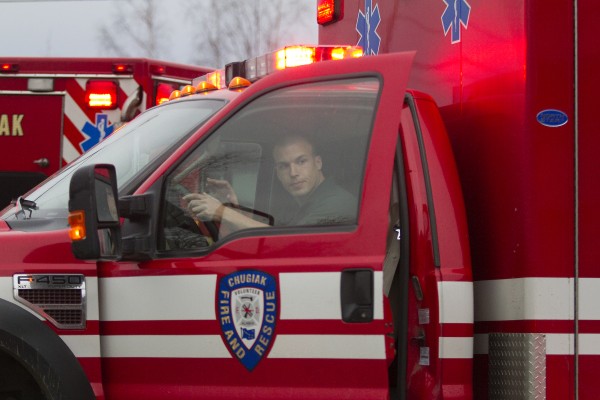
Forrest finished ambulance training so he could drive to calls while gaining practicum hours at Chugiak Volunteer Fire Department. (Photo by Philip Hall / University of Alaska Anchorage)
"It was just constantly go-go-go."
The practicum-first offered in 2013-is an excellent addition to the fire and EMT curriculum. Prior to the practicum, students would study in the classroom but, according to Tim Benningfield, "they didn't necessarily have opportunities to put the theories into practice." Now, those opportunities are everywhere.
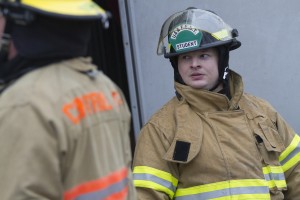
Timothy Robbins trained alongside full-time staff on a recent shift in Wasilla. (Photo by Philip Hall / University of Alaska Anchorage)
Benningfield serves as program coordinator and term assistant professor for fire and emergency services at UAA. At the start of the semester, students tell him what they hope to accomplish (and also, importantly, where and when). Tim then coordinates with four fire departments-Anchorage, Chugiak, Nikiski and Central Mat-Su in Wasilla-to help those students reach their goals as they rotate through the departments.
And the students are far from passive observers. They're actively involved, whether they're joining a rural response unit or an urban medic team. Some departments are 24-hour full-time firehouses, others are strictly volunteer-based and many are a mix of the two. The four departments provide a wide range of settings and organizational structures, letting students see the diversity of emergency services in the state. "Since we have rural, small local governments in Alaska, there's a lot of variety," Forrest added.
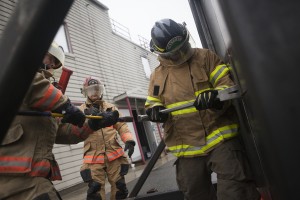
Tim, with the assistance of several full-time firefighters, busts through a steel door at the Wasilla training facility. (Photo by Philip Hall / University of Alaska Anchorage)
Consider fire student Tim Robbins' semester. "My first shift with [the Anchorage Fire Department], from 30 minutes there until the time I got done we were running calls or recovering from a call," he said. "It was just constantly go-go-go." But more recently he was at Central Mat-Su where, instead of running to calls, he was running drills at their Wasilla training facility alongside the department's latest hires.
Every day is different and, for Forrest, Tim and their classmates, that's a great thing.
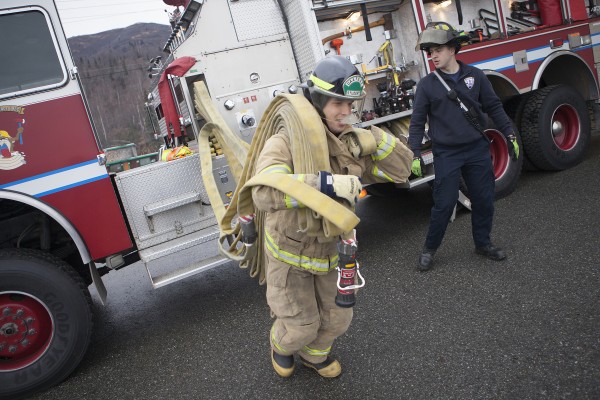
Shift captain Zak Overmeyer supervises as Forrest McDonald runs a fire hose drill during a quiet afternoon at Chugiak Volunteer Fire Department. (Photo by Philip Hall / University of Alaska Anchorage)
Making friends at the firehouse
UAA's practicum students are fundamentally part of the team when they walk in the station doors. "We'll do everything but let them go inside the burning building and drive a truck," said Zak Overmeyer, shift captain at Chugiak Volunteer Fire Department. In quiet times between calls, students can ask questions, run additional trainings or wash down the fleet (hey, somebody has to do it). The career firefighters that work on the crews also provide a great resource for insights on the field. "They're involved in it because they love the job," Forrest said of his colleagues. "It makes a huge difference when you're working where everybody wants to be here. Honestly, that's one of the greater things about this field. Pretty much every single person I've met who does this enjoys it."
The course lets students see if they too enjoy the field. Firefighters, depending on their location, can often see long slow days punctuated by intervals of intense danger. It's a pendulum swing of extreme polarities that isn't the right fit for everyone.
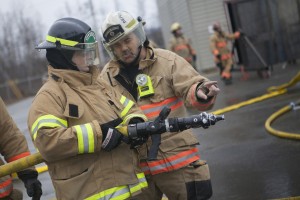
Tim gets some pointers from Deputy Chief Keenan at the Central Mat-Su Fire Department. (Photo by Philip Hall / University of Alaska Anchorage)
Forrest-whose mom also served as a volunteer firefighter in Moose Pass when he was growing up-is taking that all into consideration this semester. An Army vet, he's using his GI Bill to focus on paramedic classes at UAA. He may start an EMT career after graduation. Or he may keep studying towards a hospital job down the road. "I have a lot of options," he said. "The more hands-on experience you get, the more department environments you're able to see, the better decision you're able to make. It's given me a lot of things to think about."
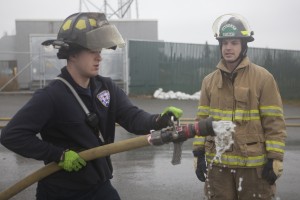
Zak and Forrest train with the fire hose outside the Chugiak Volunteer Fire Department. (Photo by Philip Hall / University of Alaska Anchorage)
And if you know it's the field for you, the practicum still provides prime firehouse connections. "If you hit it off with a captain and ask for a recommendation, you'll probably be better off than some Joe off the street with nothing," Tim said. "Part of the idea of the practicum is not just to run calls, but also to understand the fire community, the family it is and what goes on behind the scenes."
Benningfield agrees. "The most important thing to me is getting them introduced to the culture of emergency services."
There's a lot to gain from Fire 295, though the golden takeaway is the same as any field-based class, regardless of the department.
"If you're interested in getting into this career field, the most valuable thing you can have in fire/EMS is actual hands-on experience," Forrest concluded.
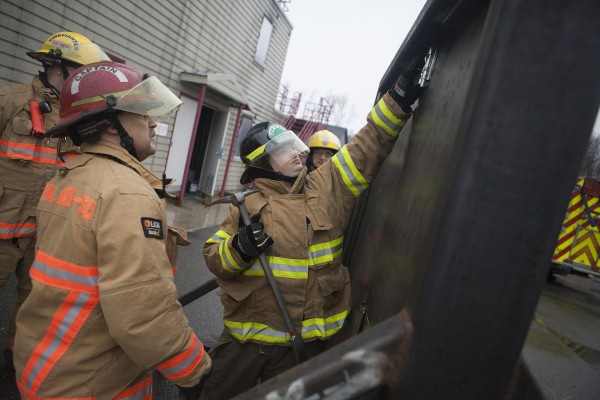
Tim attempts to bust down a steel door in a new rescue training prop at the Central Mat-Su Fire Department. (Photo by Philip Hall / University of Alaska Anchorage)
 "Trial by fire" is licensed under a Creative Commons Attribution-NonCommercial 4.0 International License.
"Trial by fire" is licensed under a Creative Commons Attribution-NonCommercial 4.0 International License.










